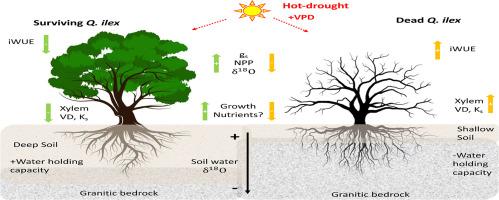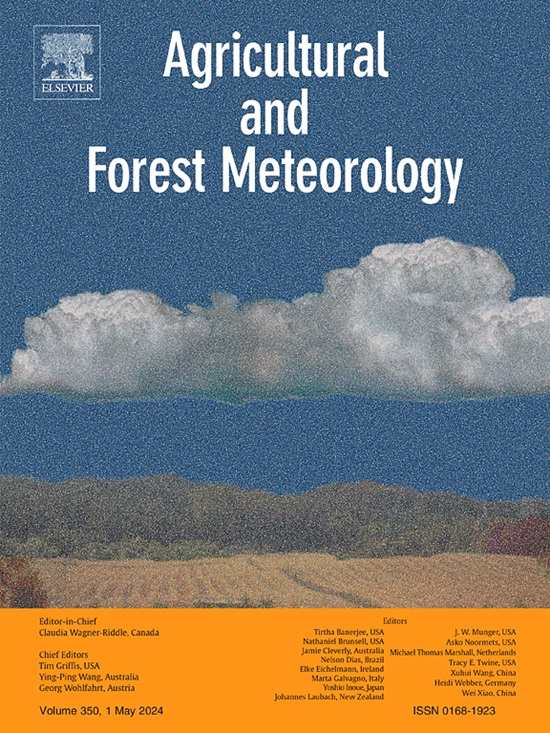Die-off after an extreme hot drought affects trees with physiological performance constrained by a more stressful abiotic niche
IF 5.6
1区 农林科学
Q1 AGRONOMY
引用次数: 0
Abstract
Forest die-off has become more frequent under climate change, making crucial to understand the physiological mechanisms of forest mortality. We analyzed Quercus ilex die-off after a record-setting hot drought in two open woodlands without previous signs of decline. To understand physiological performance of trees we compared observations of radial growth dynamics, xylem hydraulic architecture, sapwood nutrient content and 13C and in wood cellulose, with model simulations of tree carbon and water fluxes. We also assessed climate-growth responses across a Q. ilex network including sites with and without increased mortality. Past extreme droughts triggered multidecadal growth declines consistently in dead trees, which suggests long-term vulnerability of dead Q. ilex independent of the mortality process or causal factor. In the two studied woodlands, trends in xylem cellulose suggest that both dead and surviving trees increasingly relied on deeper water sources as stress increased under climate change. Dead and surviving trees followed different functional strategies reflecting chronic abiotic niche-related differences in stress. Dead trees invested similar or larger amounts of carbon in xylem reservoir tissues and less in xylem conductive tissues compared to surviving trees, yet exhibited an impaired nutrient status. Xylem hydraulic architecture differed in surviving and dead trees. The latter formed more efficient xylems with higher vessel density and larger or similar vessel sizes. The isotopic proxies suggested that dead trees systematically maintained tighter stomatal regulation and were forced to rely on deeper water likely sourced from the fractured granite bedrock. Isotopic proxies and simulations of water and carbon dynamics further suggest that surviving trees benefitted from soils with higher water-holding capacity contributing to buffer water stress. Dead trees expressed a functional paradox. Although their long-term functional strategy successfully coped with higher baseline water stress, they failed to withstand the additional increase in stress during an unprecedented hot drought.


极端炎热干旱后的死亡会影响树木的生理性能,这些生理性能受到更有压力的非生物生态位的限制
在气候变化的影响下,森林死亡变得更加频繁,这对于了解森林死亡的生理机制至关重要。我们分析了两个开放林地在创纪录的高温干旱后的栎树死亡,之前没有下降的迹象。为了了解树木的生理性能,我们比较了树木径向生长动态、木质部水力结构、边材养分含量和木材纤维素中δ13C和δ18O的观测结果,以及树木碳和水通量的模型模拟。我们还评估了包括死亡率增加和没有死亡率增加的地点在内的冬青网络的气候增长响应。过去的极端干旱导致枯死树木的生长持续下降,这表明枯死冬青的长期脆弱性与死亡过程或因果因素无关。在两个研究的林地中,木质部纤维素δ18O的变化趋势表明,随着气候变化下压力的增加,死亡和存活的树木越来越依赖于更深的水源。死亡和存活的树木遵循不同的功能策略,反映了慢性非生物生态位相关的压力差异。与存活的树木相比,死亡树木在木质部储存库组织中投入了相似或更多的碳,而在木质部传导组织中投入了较少的碳,但却表现出营养状况受损。木质部水力结构在活树和死树中存在差异。后者形成更有效的木质部,具有更高的导管密度和更大或相似的导管尺寸。同位素代用物表明,死树系统地保持了更严格的气孔调节,并被迫依赖可能来自断裂的花岗岩基岩的较深的水。同位素代用物和水碳动态模拟进一步表明,幸存的树木受益于具有较高持水能力的土壤,有助于缓冲水分压力。枯树表达了一种功能上的悖论。尽管它们的长期功能策略成功地应对了更高的基线水压力,但它们未能承受前所未有的高温干旱期间额外增加的压力。
本文章由计算机程序翻译,如有差异,请以英文原文为准。
求助全文
约1分钟内获得全文
求助全文
来源期刊
CiteScore
10.30
自引率
9.70%
发文量
415
审稿时长
69 days
期刊介绍:
Agricultural and Forest Meteorology is an international journal for the publication of original articles and reviews on the inter-relationship between meteorology, agriculture, forestry, and natural ecosystems. Emphasis is on basic and applied scientific research relevant to practical problems in the field of plant and soil sciences, ecology and biogeochemistry as affected by weather as well as climate variability and change. Theoretical models should be tested against experimental data. Articles must appeal to an international audience. Special issues devoted to single topics are also published.
Typical topics include canopy micrometeorology (e.g. canopy radiation transfer, turbulence near the ground, evapotranspiration, energy balance, fluxes of trace gases), micrometeorological instrumentation (e.g., sensors for trace gases, flux measurement instruments, radiation measurement techniques), aerobiology (e.g. the dispersion of pollen, spores, insects and pesticides), biometeorology (e.g. the effect of weather and climate on plant distribution, crop yield, water-use efficiency, and plant phenology), forest-fire/weather interactions, and feedbacks from vegetation to weather and the climate system.

 求助内容:
求助内容: 应助结果提醒方式:
应助结果提醒方式:


